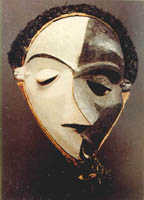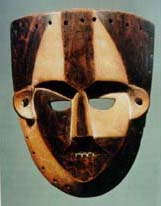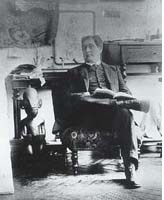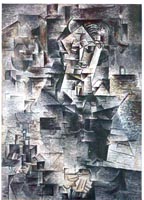 |
|
|
| Mbuya Mask | Girl B4 Mirror | Mask Boa | Head Of A Man |
 |
 |
 |
 |
| Masque Mbuya | Jeune Fille au Miroir | Masque Boa | Masque Boa |
| Masque Grebo | Guitare-1912 | Masque Dogon | Tête-1958 |
 |
 |
 |
 |
| Grebo Mask | Guitar1912 | Dogon Mask | Head1958 |
Paraphrasant
les abstracts de "Apollinaire
and Primitivism"
G. Apollinaire dans le studio de Picasso. 1910-1912 |
Gauguin:"The only way to
rise toward God is to create as He does." Early 20th century artists realized "their ignorance", and like Gauguin turned to African Art for Enlightment. African Art taught them the distinction between visual or perceptual reality and the reality of knowledge or of concepts that echoes the western philosophical premise that goes back to Plato. Golberg internalized deformation as the basis of creation and abstraction as its operating principle; he learned to draw a distinction between "emotive deformation" and "spiritual or rational deformation" and to connect to the dialectic between the Dionysiac and the Apollonian, passion and reason, "the very principle of life". Both Apollinaire and Picasso internalized the "moral lesson" of African See-through Sculptures. What moved them most in this art is the SYMBIOSIS OF THE APOLLONIAN AND DIONYSIAC, LOGIC AND PASSION. African Art and the Dimension of Infinity. Max Weber, in "Camera Work(July 1910)", understood what the fourth dimension is all about. Although the 4th dimension was basically a perceptual or imaginative faculty, he related it to the creative process itself, to the artist's capacity to endow his works with a potential sense of grandeur, no matter what their actual size or scale. A Tanagra, Egyptian or Congo statuette often gives the impression of a colossal statue... A form at its extremity still continues reaching out into space if it is imbued with intensity and energy." What gives plasticity to objects, gives them their just proportions. Apollinaire cites ANCIENT EGYPTIAN AND AFRICAN ART as THE ONLY EXAMPLES FROM THE ART OF THE PAST POSSESSING THE QUALITY OF THE FOURTH DIMENSION. |
| "Confessions
Esthetiques:" D.-W. KAHNWEILER 
Portrait de Daniel Kahnweiler, 1910 |
La sculpture nègre montre
les choses avec le minimum de moyens. Son modèle est simplifié à
l'extrême, supprime tout ce qui n'est pas essentiel. L'unité de
chaque sculpture est entière, chaque partie étant soumise strictement
à l'ensemble. Une Sculpture africaine est signe, emblème, dans son ensemble comme dans chacun de ses détails; elle aboutit, dans l'imagination du spectateur, à la création de la "réalité" signifiée. Peu à peu, nous apprenions à mieux connaître les oeuvres d'art africaines - dont la vraie nature est celle d'écritures. Ce n'est que quelques années plus tard que les peintres cubistes, les ayant étudiées, allaient y puiser un enseignement dont les resultats devaient être fondamentaux pour la sculpture européenne. Les peintres cubistes découvrirent, dans certains masques de la Côte-d'Ivoire, des SIGNES qui, renonçant à toute imitation, chargeaient l'aperception du spectateur d'imaginer le visage dont ces masques n'imitaient pas les "vraies" formes. Ce fut là, la découverte décisive qui permit à la peinture la création de signes inventés, qui libéra la sculpture du bloc, l'amena à la TRANSPARENCE. |
| Prime Mimesis :NOK | AFRICAN ART | Books | Support | Site Map |
| Mimesis Premiere: Nok | ART AFRICAIN | ARTMODERNE |Livres | Contacter | Plan duSite |
|
FHimageprotect V1.2 |